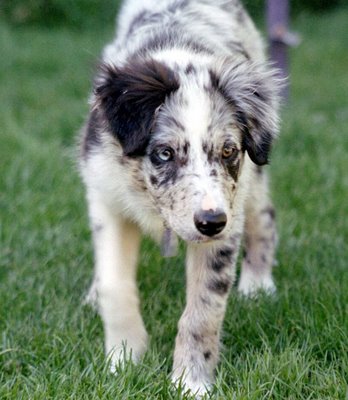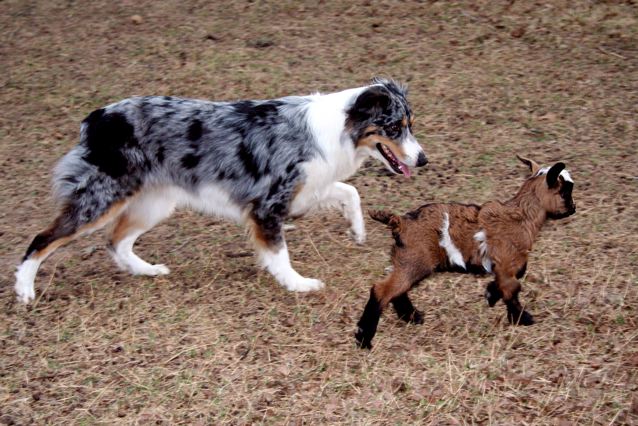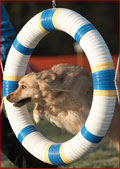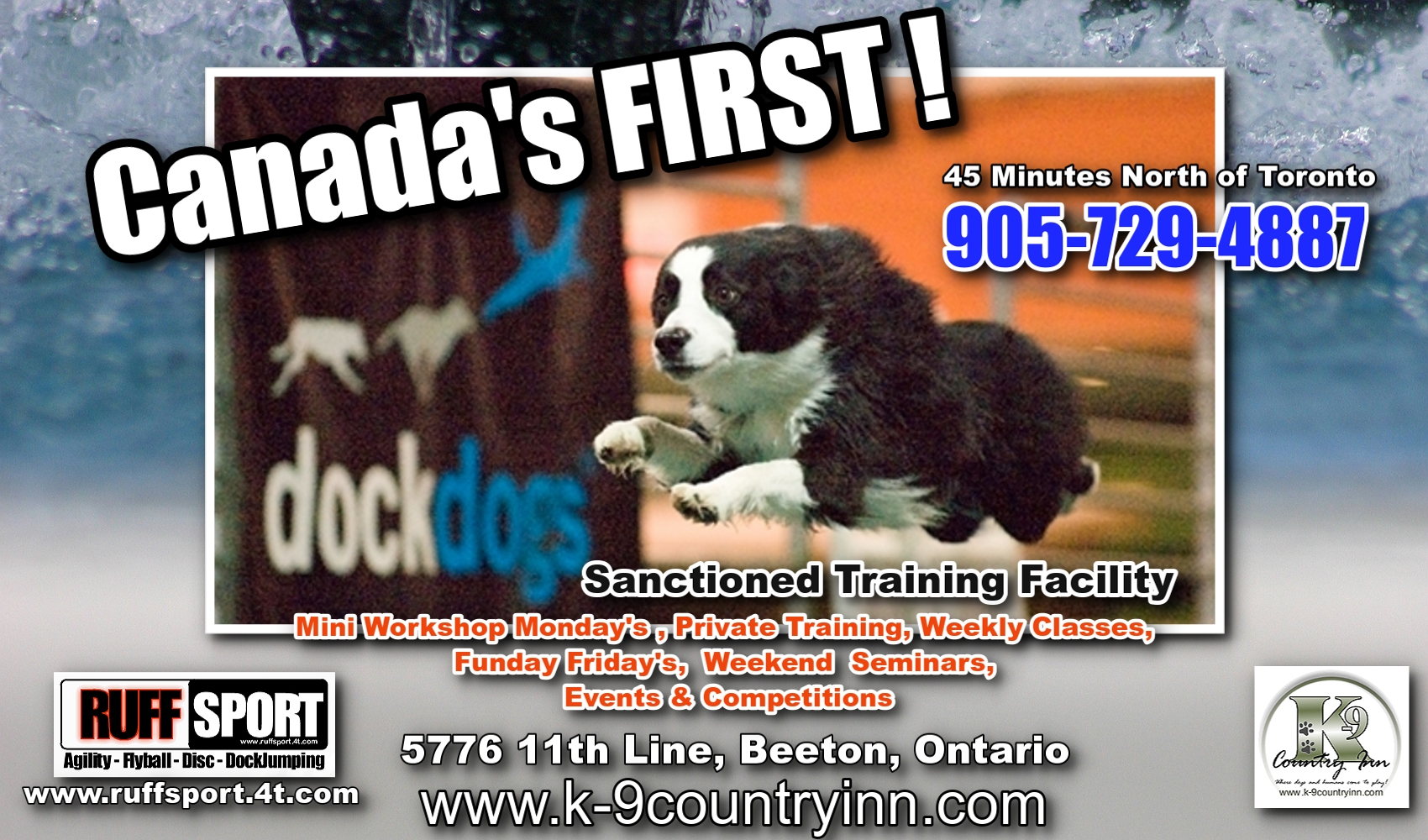Got Puppy Fever? Could A "Herding Dog" Be Your Perfect Sports Dog?
Originally the dogs in the American Kennel Club’s Herding Group were part of the Working Group, but reorganization in 1983 spotlighted these breeds in a group of their own. Herding dogs were bred for the ability to control the movement of other animals. This ability was traditionally developed for tending sheep and cattle, but can be directed to other pursuits.
One modern-day example of the use of herding instinct is controlling wild geese at airports and golf courses. The dogs doing this job are often Border Collies, who eagerly perform the task without harm to geese or humans.
Herding dogs need jobs. Misdirected herding instincts can result in dogs herding your other companion animals, family members and guests. People often find the early manifestations of off-target herding behaviors funny, but much less funny as the dog gets more and more vigorous.
A young, small pup who cutely woof-woofed and playfully ran at guests leaving the house—or dangled by teeth from people’s pants legs as they walked--may now be large and going for sharp nips at their heels. The key is to redirect this behavior right from the start, never stopping to laugh at it but going right into training action. A mouth busy with a tennis ball or other toy isn’t free to nip people. A dog reliably trained and directed to sit or down and wait for further instructions can’t be running at humans at the same time.
Herding dogs may need guidance for safe behavior around your other companion animals. If you have another dog who can’t comfortably endure being jostled, nipped and chased by a busybody herding dog; you’ll have to direct the herding dog’s behavior with the other dog. This can mean not leaving them alone together, at least for awhile.
You can also have this problem with a herding dog around horses and cats. Don’t expect to let the horse train the dog with kicks or the cat train the dog with scratches. Not only can the injuries be serious, but getting attacked by the other animal can bring out defensive aggression in the dog and take the problem to a whole new level.
Herding dogs need thinking handlers who stay one step ahead. These are some of the smartest and most active breeds of the dog world. The Belgian Sheepdog and Belgian Tervuren breed standards both state “usually in motion when not under command,” and the other herding breeds tend to be similarly active. They’ve been called workaholics because they stay busy.
Translation: if you don’t give a herding dog a job, the dog will find one. Chances are good you will not agree it’s a job that needs doing. Pulling up small trees, “protecting” your yard from the meter reader, or crashing through a window to chase the mail carrier are things a busy herding dog might do in a normal state of mind.
If abnormal mental states, such as separation anxiety or noise phobia (fireworks and thunderstorms are common issues), become factors you can see results like tearing apart doors and door frames to get into or out of a house. A fence will not hold a dog who is sufficiently motivated to leave, which is one reason there are so many “shepherd mixes.” Energy that is not properly channeled can change from a wonderful power to an awesome problem.
Training
The key to living successfully with a herding breed is training. People who enjoy training dogs and who are mentally in tune with these brilliant canines have an absolute ball with them.
Dog training was practically invented for the German Shepherd Dog. The Border Collie has been ranked number one in intelligence of all breeds. Every breed in the herding group is practically a canine genius. Training tends to reduce sassiness in a dog inclined to be pushy, and to increase confidence in a dog who might otherwise be overly soft.
The intelligence and trainability of herding breeds is the good news. The bad news, to people without time or interest in training, is that it just isn’t fair to these dogs to deprive them of training and of a life that gives them something interesting to do on a daily basis to engage with their world.
Several of the herding breeds are so eager that they are easy to train. That statement is deceptive, though. If you’re not on the right wavelength with the dog, training will be far from easy for you.
Think of a situation where you want to buy something and a salesperson wants to sell it to you. You are ready to buy, but the salesperson doesn’t understand your language well enough to realize that, and keeps trying to push you to buy it. You want to hand over your money, pick up your item, go home and start using it—and they just keep forcing you to listen to a heavy-handed sales pitch!
This is precisely what happens when people try to train a herding breed without understanding the dog’s body language and way of thinking. These dogs understand quickly and remember things well. Losing your temper with them destroys their trust in you and prevents them from doing what you want them to do. They require fewer repetitions to learn tasks than other breeds, but they need adequate practice to get used to the situations in which they will work. And that leads to something else essential to living successfully with a herding breed.
Socialization
The work of a herding dog was traditionally done with livestock in places suitable for livestock to be kept, transported and handled. Herding dogs often had a dual role of controlling the movement of the stock and protecting both the stock and the human family. While neither shy nor aggressive temperaments are correct for any of these breeds, it’s normal for them to be aloof with strangers.
In urban society, dogs need to be able to cope with more people than is typical for a herding dog working a farm. This requires early and continued socialization to a wide variety of people, places and things. If you don’t socialize, your dog may decide to make a life’s work of herding cars, garbage trucks, dishwashers, lawnmowers, kids on skateboards, or you name it. The high level of responsiveness needed to take direction and control livestock can turn into hyper-reactivity that makes the dog miserable and in extreme cases even dangerous.
The solution is to combine training with socialization—take the dog to training class and practice the class homework daily in a wide variety of safe settings. Make training a way of life with your herding breed. If this is how you enjoy interacting with a dog, a dog of one of the herding breeds may be your dream dog.
Conditioning to Handling
The herding breeds range from short-coated dogs like the Malinois to heavily coated breeds that include the Old English Sheepdog. You’ll need to be sure whichever breed you choose is one you’ll be able to keep groomed, since a matted dog gets sore and tends to become defensive about being touched, much less groomed.
You need to be able to put your hands on your dog at any time without startling the dog into a defensive reaction. The best insurance of being able to do this is to spend time doing it every day in a grooming session. You’ll have a great-looking, healthy dog with the best chance of getting along with children, being handled safely at the veterinarian’s office and all the other things we need our dogs to be able to tolerate.
Herding work involves nipping at livestock animals to move them along. This instinctive behavior can carry over to people if the dog isn’t trained properly, and that training needs to start the minute you get the dog. Particularly in the breeds specialized for sheep herding, the nipping may be gentle. That’s the perfect time to teach the dog not to put teeth on human skin at all, and then no one should be accidentally injured by dog teeth in play.
Some of the herding dogs will merely poke you rather than nipping to move you along. It may seem cute, but it can easily escalate, so you need to stop it from the start. Happily it’s a simple problem to remedy—all you have to do is stop! The dog is poking you to get you to move faster, typically toward meal preparation.
When fixing the dog’s dinner, you have the dog’s full attention, making it an excellent time to train. When poked, simply stop. Wait a few seconds, and then start to walk again. If you are again poked, immediately stop. It doesn’t take much of this for a smart dog to learn that poking only slows you down! Do this anytime the dog pokes you, jumps on you, nips at you or does anything else to get you to move. Don’t move. Be the incredible stop-action human!
It’s a common misconception that herding instinct or herding behavior is the equivalent of dominance. This trait is important to understand in order to get on the wavelength to communicate effectively with a herding dog. Herding instinct is a need to interact with others in the environment. The dog has a strong need to act and see a reaction. You could say the dog has a need to manipulate the environment.
The herding dog needs to be able to take initiative—to offer you a behavior and be right, to find it was pleasing to you and have you acknowledge the dog did something for you before you asked. If the dog is wrong about what you want, the dog needs you to understand it was an honest mistake, and not punish.
This is not dominance. A dog can be very submissive and have strong herding behaviors. The dog is not trying to push you around. And if the dog is trying to manipulate you, it is in an effort to serve you. This is what a herding dog wants out of life.
Lifestyles
Obviously herding, either with your own livestock or in herding competitions, is one work choice. Herding livestock calls for agility, making it no surprise that some of the top breeds in agility competition come from the herding group. Agility keeps a dog busy in both mind and body and requires a lot of training, so it can be a good fit for these busy dogs.
Other dog sports such as Rally Obedience, Tracking, Schutzhund and Freestyle (dancing with your dog) are natural activities for herding breeds, too. Herding dogs with the right dispositions and socialization are serving well as therapy dogs and as assistance dogs to people with disabilities.
The temperaments of herding dogs are as complex as their wonderful brains. Smart dogs are the most difficult dogs to live with, unless your chosen lifestyle is one of close companionship and communication with your dog. In that case, herding dogs make excellent company, tending to know where you are and what you’re doing at all times. For a herding dog, this is a life with purpose.






 Ontario Dog Sports
Ontario Dog Sports
Reader Comments